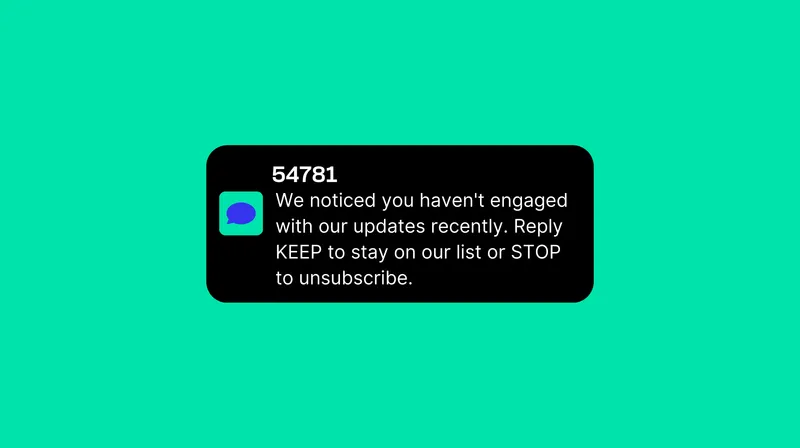Messaging
SMS Opt In Strategies: Building a Compliant List
Our comprehensive guide covers best practices, compliance, and how to manage your SMS marketing campaigns effectively.

SMS marketing has proven itself as a valuable asset for businesses looking to engage with their customers through a personalized, real-time approach that surpasses other communication channels.
The cornerstone of successful SMS campaigns lies in adhering to SMS opt-in best practices and industry guidelines.
SMS opt-in is the process through which customers give their explicit consent to receive marketing text messages, ensuring your communication is both welcome and legally compliant.
Take advantage of insights from 1 billion+ messages with our '2023 Guide to SMS and MMS'. Download your copy to learn from Telnyx experts and shape your ideal SMS/MMS strategy.
In this comprehensive guide, we will delve into the intricacies of SMS opt-in, examining its significance, various opt-in methods, critical regulations, and efficient management of your SMS opt-in lists to optimize your marketing efforts.
Why is SMS opt-in important for businesses?
SMS opt-in plays a critical role in SMS marketing. You can build trust and a strong relationship with your audience by obtaining explicit customer consent to receive your messages, which ensures compliance with legal guidelines, reduces spam complaints, and fosters positive customer experiences. In addition, engaging with an audience that’s subscribed to your messages can lead to higher engagement and conversion rates.
For instance, imagine a local gym that wants to send its members promotional offers and class schedules. By using an SMS opt-in process, the gym ensures that it only sends messages to members who are interested in receiving them. This targeted approach can lead to higher member satisfaction and better results from promotional campaigns.
Types of SMS opt-in: Exploring single and double opt-in
When it comes to SMS opt-in, there are two main types that businesses can choose from to build their subscriber list, each with its own pros and cons.
Single opt-in
Customers provide consent by entering their phone number, usually through a form or by texting a keyword to a short code.
Pro: This method is easier and faster than the double opt-in process.
Con: It may result in invalid or mistyped phone numbers.
Double opt-in
After the initial opt-in, customers receive a confirmation text message to which they must reply, usually with a keyword, to confirm their subscription.
Pro: This method ensures a higher quality list with valid and engaged subscribers.
Con: It may lead to a lower overall subscription rate than the more straightforward single opt-in process.
Before choosing a method, you should weigh the pros and cons of each to determine the best approach for your business and audience.
SMS opt-out: Giving customers control
Maintaining a healthy relationship with your audience and complying with regulations also involves providing an easy, straightforward way for customers to opt out of your SMS messages. Including opt-out instructions in your initial message and sending periodic reminders respects your customers' preferences and helps you avoid potential legal issues.
For example, an online clothing store might send regular promotional texts to its subscribers. By including a simple "Reply STOP to unsubscribe" message, the store ensures customers can easily opt out if they no longer wish to receive promotional messages.
Regulations and guidelines: TCPA and CTIA
In the U.S., the Telephone Consumer Protection Act (TCPA) and the Cellular Telecommunications and Internet Association (CTIA) guidelines govern SMS marketing. These organizations protect consumers and help maintain a fair marketing environment.
While the CTIA won’t fine you for ignoring their guidelines, non-compliance could lead to violations of other privacy and security laws (like the TCPA). The penalties for violating TCPA regulations include an immediate shutdown of your messaging service or fines ranging from $500 to $1,500 per message. Therefore, you must understand the regulations and guidelines before sending business messages.
Here’s a quick overview of what you need to do to comply:
- Obtain express written consent from customers before sending SMS messages.
- Provide clear and conspicuous opt-out instructions.
- Respect time restrictions for sending messages.
- Maintain accurate and up-to-date opt-in and opt-out records.
Adherence to these regulations and guidelines is crucial for any business engaging in SMS marketing.
Best practices (with examples) for managing SMS opt-in lists
To ensure the success of your SMS campaigns, consider adopting these best practices:
Directly mention SMS in opt-in forms / Terms & Conditions
When someone opts into SMS communications, its helpful to specifically mention SMS in the opt-in form and your Terms & Conditions. 10DLC, the major compliance framework in the USA, actually requires this, and we've seen campaigns get rejected for this reason.
Example: Your opt-in form mentions "tick this box to opt-in to receive SMS text messages from (Your Company Name). Standard rates and data may apply. Reply STOP to opt out."
Double opt-in
Using a double opt-in process can significantly improve the quality of your list, leading to more engaged subscribers and better results.

Example: A pizza delivery service might use double opt-in to ensure their SMS subscribers are genuinely interested in receiving promotional offers and updates.
Regular list maintenance
Clean and update your lists regularly to remove invalid numbers and disengaged subscribers, ensuring your messages reach the right audience.

Example: An event management company might periodically remove inactive subscribers from their list to maintain high levels of engagement and deliverability.
List segmentation
Segment your lists based on subscriber preferences and behavior to deliver targeted and relevant messages.

Example: A travel agency could segment its list based on customers' preferred travel destinations, sending tailored offers and updates accordingly.
Personalization
Increase relevance and engagement by personalizing messages and offers for your subscribers.

Example: A cosmetics retailer might use purchase history data to send their SMS subscribers personalized product recommendations and special offers.
Performance monitoring
Monitor and analyze your campaign performance to optimize future efforts and identify areas of improvement.

Example: A fitness studio could track the success of different SMS promotions to refine its messaging strategy and better target its audience.
Let’s put these best practices together in a final example. A dental clinic uses a double opt-in process to ensure it only sends appointment reminders and promotional offers to its current interested patients. The clinic can deliver more relevant and personable content by personalizing its messages and segmenting its list based on patient preferences—such as orthodontics, pediatric dentistry, or cosmetic dentistry.
The result? Improved patient satisfaction and increased appointment bookings.
Get started with SMS marketing—the right way
SMS opt-in is an essential component of successful SMS marketing campaigns. By understanding the importance of consent, following regulations, and implementing best practices, your business can build a strong, engaged audience and maximize the benefits of SMS marketing.
Telnyx provides tools for managing SMS opt-out keywords and stop words to help ensure your messaging campaigns adhere to TCPA and CTIA guidelines. With Telnyx's SMS API, you can create business messaging suited to your needs. We’ll also help you implement SMS opt-in processes, comply with industry regulations, and optimize your campaigns for better performance.
Contact our team of experts to learn how SMS marketing powered by Telnyx can help you transform your business communication strategy.
Always consult your legal team and the appropriate regulatory authorities before using SMS or MMS messaging for your business. In the meantime, be sure to read our SMS guide and Compliance Guide to help demystify some of the rules and regulations surrounding business messaging.
Share on Social
Sign up for emails of our latest articles and news
Related articles
